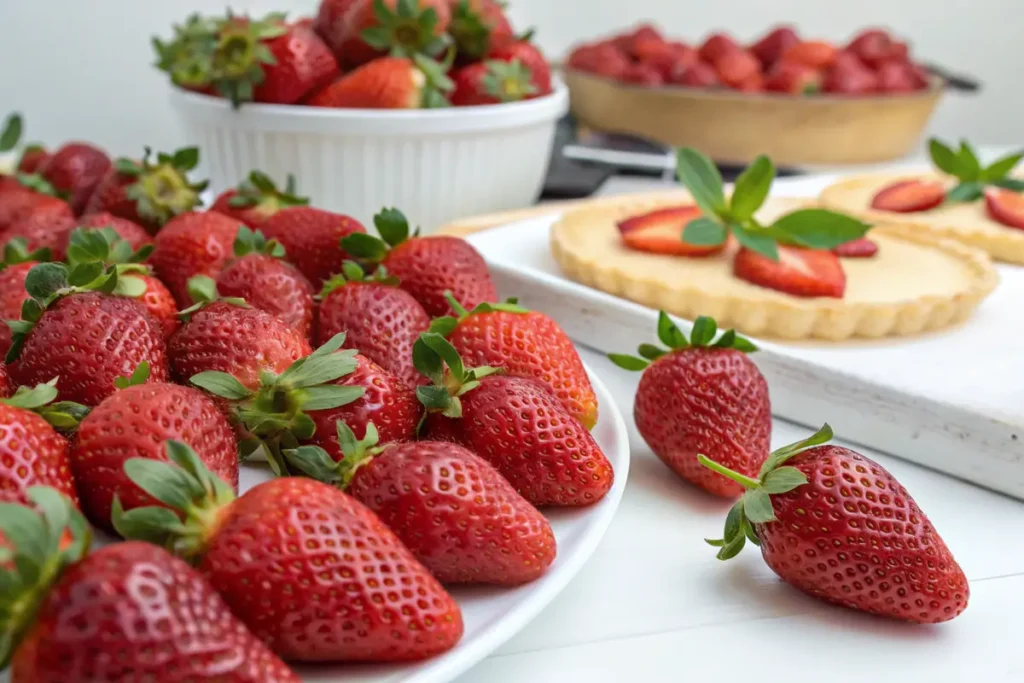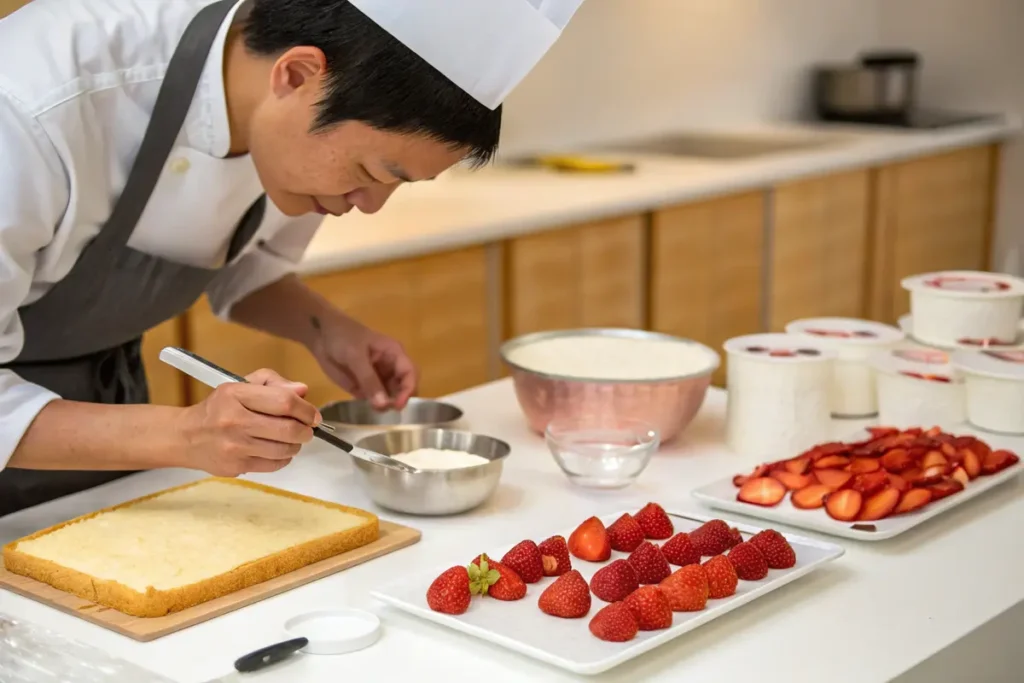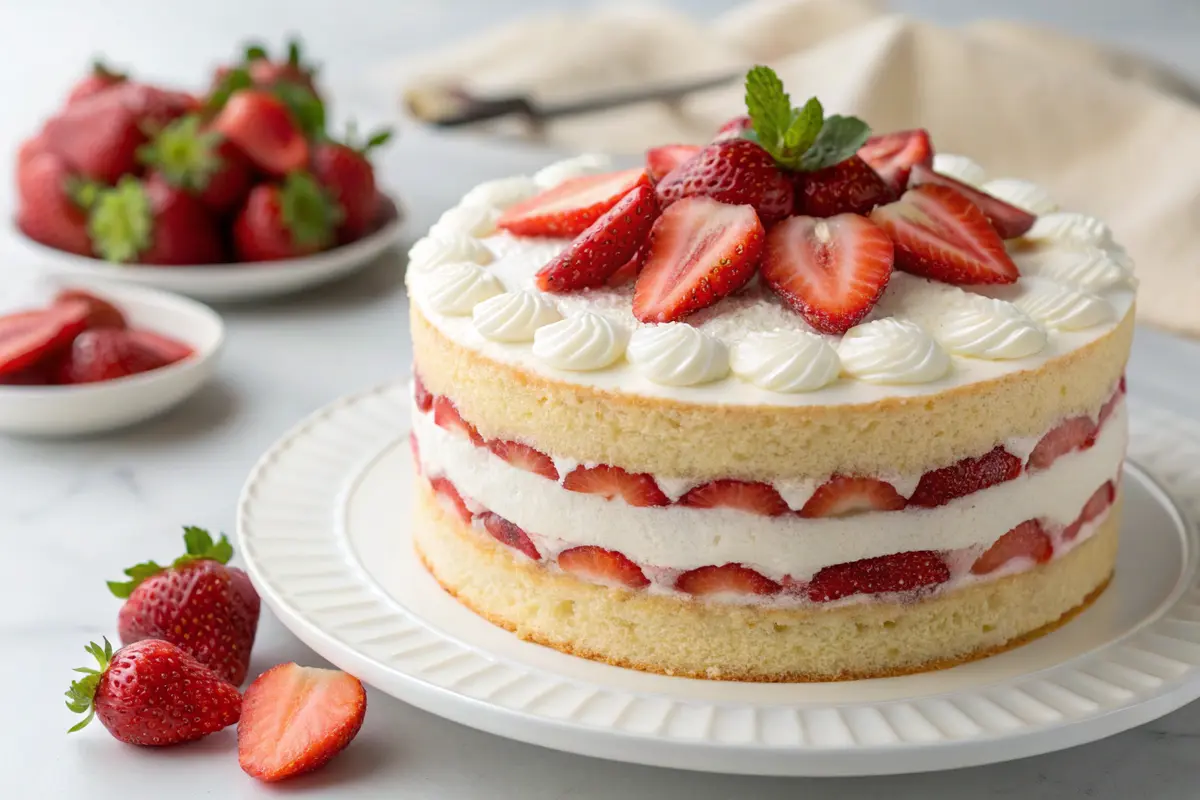Table of Contents
Japanese Strawberry Cake Yield is a topic filled with delicious potential and baking precision. It’s about understanding how to create the perfect balance of light, airy sponge cake, creamy whipped cream, and sweet, juicy strawberries to achieve a truly delightful dessert. This article delves into the secrets to mastering Japanese Strawberry Cake yield and consistently creating this beloved treat. Optimizing your Japanese Strawberry Cake Yield is key to a successful bake.
Understanding Japanese Strawberry Cake Fundamentals

Japanese Strawberry Cake, often called “Strawberry Shortcake” or “Fraise Cake,” is characterized by its delicate sponge cake layers, light and not-too-sweet whipped cream frosting, and fresh strawberry filling. Getting the yield right means having the perfect proportions of each component so every slice is a balanced bite. It’s a matter of taste, texture, and visual appeal. Consistent Japanese Strawberry Cake Yield is something all bakers strive for.
The sponge cake base, often a Genoise or chiffon cake, is crucial. Its airy texture is essential for complementing the rich cream and juicy strawberries. Achieving the right cake volume is key to a successful yield. It is important to understand the role of each ingredient in leavening. A high-quality sponge is essential for a great Japanese Strawberry Cake Yield.
The whipped cream frosting needs to be stable enough to hold its shape but light enough to not overwhelm the cake. The proper whipping technique and the addition of stabilizers, if necessary, can significantly affect the yield in terms of frosting coverage and structure. Achieving the proper whipped cream frosting for optimal Japanese Strawberry Cake Yield is essential.
Finally, the quality and quantity of the strawberries matter. Selecting ripe, flavorful berries and using the right amount ensures a perfect balance of sweetness and acidity in each bite. A good strawberry yield prevents a soggy cake. Ensuring the best possible fruit selection improves the overall Japanese Strawberry Cake Yield.
Achieving the Perfect Sponge Cake Yield
The sponge cake is the foundation of Japanese Strawberry Cake. Getting the right yield in terms of height, texture, and crumb structure is vital. Several factors contribute to this success. The key to achieving a wonderful Japanese Strawberry Cake Yield is the perfect sponge.
Firstly, the egg foaming technique is critical. Whether you’re making a Genoise or a Chiffon cake, properly whisking the eggs with sugar to create a stable foam is essential for volume. This foam traps air, which expands during baking, resulting in a light and airy cake. Properly foamed eggs ensure a nice Japanese Strawberry Cake Yield.
Secondly, the ratio of wet to dry ingredients is important. Too much liquid can weigh down the cake, while too little can result in a dry and dense texture. Accurate measurements and careful mixing are necessary to achieve the right balance. The right balance creates a nice lift during baking and helps maximize Japanese Strawberry Cake Yield.
Thirdly, the baking temperature and time play a crucial role. An oven that is too hot can cause the cake to rise too quickly and then collapse. An oven that is not hot enough will result in a dense, undercooked cake. Experimentation and careful monitoring are key. You should watch the cake’s color. Understanding baking temperature is critical for achieving the ideal Japanese Strawberry Cake Yield.
Image Placeholder: alt text showing various stages of a perfectly risen sponge cake, with the final image labeled “Perfect Japanese Strawberry Cake Yield.”
Mastering Whipped Cream Frosting for Optimal Coverage
The whipped cream frosting is what ties the whole Japanese Strawberry Cake together. Achieving the right yield means creating a stable, light, and flavorful frosting that holds its shape without being too sweet or heavy. There are several factors that affect the end result. Optimal whipped cream coverage is important to ensure that you can get the desired Japanese Strawberry Cake Yield.
The type of cream used is important. Heavy cream with a high fat content (at least 35%) is essential for proper whipping and stability. Lower-fat creams may not whip properly or hold their shape.
The whipping technique also matters. Over-whipping can result in grainy or buttery cream, while under-whipping can result in a runny, unstable frosting. Using a chilled bowl and beaters helps stabilize the cream. Proper whipping technique is key to achieving the ideal Japanese Strawberry Cake Yield.
Adding a stabilizer, such as gelatin or cornstarch, can help prevent the whipped cream from weeping or collapsing, especially in humid conditions. However, it’s important to use the stabilizer sparingly to avoid altering the texture or flavor of the frosting. The best stabilizers are often flavorless. Careful stabilizer usage is essential to a delightful Japanese Strawberry Cake Yield.
Strawberry Selection and Preparation for Ideal Balance
The strawberries provide the sweet and juicy element that defines the Japanese Strawberry Cake. Selecting the right berries and preparing them properly is important for achieving an ideal yield. Picking the right strawberries is key to a good Japanese Strawberry Cake Yield.
Choose ripe, flavorful strawberries that are uniformly red in color. Avoid berries that are pale, mushy, or have signs of bruising or mold. A mix of sizes can add texture.
Wash and dry the strawberries thoroughly before slicing or halving them. Removing excess moisture prevents the cake from becoming soggy. Patting them dry with a paper towel is a helpful method.
Consider macerating the strawberries with a small amount of sugar or liqueur. This enhances their flavor and draws out some of their juices, which can then be used to moisten the cake layers. Don’t overdo the maceration, though. Proper strawberry preparation is important to guarantee the desired Japanese Strawberry Cake Yield.
Image Placeholder: A photo comparing different strawberry sizes, with a close-up showing the cross-section of a perfectly ripe strawberry, showcasing “Japanese Strawberry Cake Yield” quality.
Secret Ingredients for an Unforgettable Cake
While the basic ingredients of Japanese Strawberry Cake are simple, incorporating certain secret ingredients can elevate the flavor and texture to another level. It’s all about enhancing the already delicious components. Adding a touch of secret ingredients enhances the overall Japanese Strawberry Cake Yield.
Adding a touch of citrus zest, such as lemon or orange, to the sponge cake batter can brighten the flavor and add a subtle aroma. A teaspoon of lemon zest can make a difference.
Using a high-quality vanilla extract or bean paste in the whipped cream frosting enhances the sweetness and depth of flavor. Real vanilla is always better than imitation. Vanilla is a great addition to make the Japanese Strawberry Cake Yield even more tasty.
Consider adding a touch of almond extract to the cake or frosting for a subtle nutty flavor. Just a few drops can make a big impact. It’s important to use it sparingly.
Preventing Common Baking Mishaps
Even experienced bakers can encounter problems when making Japanese Strawberry Cake. Knowing how to prevent and address these issues can ensure a successful yield every time. You should also know how to fix errors to get the best Japanese Strawberry Cake Yield.
A common problem is a dry or crumbly sponge cake. This can be caused by over-baking, using too much flour, or not enough liquid. Adjust the baking time and ingredients accordingly. Weighing ingredients can help avoid these problems.
Another issue is unstable whipped cream that weeps or collapses. This can be prevented by using heavy cream with a high fat content, chilling the bowl and beaters, and adding a stabilizer. Humidity can also be a factor.
A soggy cake can result from using too much strawberry juice or macerating the berries for too long. Drain the strawberries well before adding them to the cake, and avoid over-saturating the cake layers with liquid. Proper draining is key.
Japanese Strawberry Cake Yield: Tips for Consistent Results
Achieving consistent results with Japanese Strawberry Cake requires attention to detail and consistent techniques. These tips will help you create a perfect cake every time. Following these tips should result in a delicious and impressive Japanese Strawberry Cake Yield.
Always use fresh, high-quality ingredients. The flavor and texture of the cake will be directly affected by the quality of the ingredients you use.
Measure ingredients accurately using a kitchen scale. Baking is a science, and precise measurements are essential for consistent results.
Follow the recipe carefully, paying attention to the order of operations and mixing techniques. Don’t skip steps or substitute ingredients unless you are confident in your understanding of the recipe.
Image Placeholder: A well-lit photo of a perfectly assembled Japanese Strawberry Cake, sliced to show the layers of cake, cream, and strawberries, with the title “Japanese Strawberry Cake Yield Perfection” as alt text.
Japanese Strawberry Cake Yield: Understanding Cake Size
Japanese Strawberry Cake’s yield can be expressed in different terms. However, the total surface area of the cake (and therefore the number of slices that can be cut from it) is affected by the size of the baking pan. The right cake size is critical for the perfect Japanese Strawberry Cake Yield.
Consider the volume of the batter for your cake. A small pan will result in a tall, dense cake, and a larger pan will produce a flatter cake. If you have a small amount of batter, a small pan may be the right answer.
If you want to adjust the cake’s diameter, you may have to adjust the baking time accordingly. As the cake bakes, it is best to monitor it closely. When baking, keep the oven door closed.
Japanese Strawberry Cake Yield is ultimately determined by the desired output. Whether you want a small cake for yourself or a large cake for a party, you must always consider the size of the pan you are using.
The Ultimate Japanese Strawberry Cake Yield Guide

Japanese Strawberry Cake is a popular dessert, and there are many ways to make it. The following guide will show you how to make the perfect cake for your needs. Follow this guide to achieve great Japanese Strawberry Cake Yield.
Ingredients:
- 1 cup all-purpose flour
- 1 teaspoon baking powder
- 1/4 teaspoon salt
- 1/2 cup granulated sugar
- 2 large eggs
- 1/4 cup milk
- 2 tablespoons melted butter
- 1 teaspoon vanilla extract
- 1 cup heavy cream
- 2 tablespoons powdered sugar
- 1 pint fresh strawberries, sliced
Instructions:
- Preheat oven to 350 degrees F (175 degrees C). Grease and flour a 9-inch round cake pan.
- In a medium bowl, whisk together the flour, baking powder, and salt.
- In a large bowl, beat together the sugar and eggs until light and fluffy.
- Gradually add the dry ingredients to the wet ingredients, alternating with the milk, and mix until just combined.
- Stir in the melted butter and vanilla extract.
- Pour the batter into the prepared cake pan and bake for 25-30 minutes, or until a toothpick inserted into the center comes out clean.
- Let the cake cool in the pan for 10 minutes before inverting it onto a wire rack to cool completely.
- In a medium bowl, beat the heavy cream and powdered sugar until stiff peaks form.
- Slice the cake horizontally into two layers.
- Spread half of the whipped cream over the bottom layer of the cake.
- Arrange the sliced strawberries over the whipped cream.
- Top with the remaining whipped cream and the top layer of the cake.
- Dust with powdered sugar and serve.
Enjoy your perfect Japanese Strawberry Cake!
Japanese Strawberry Cake Yield: Recipe Variations
While the classic Japanese Strawberry Cake is delicious on its own, there are many variations that can be explored to add a unique twist. The possibilities are endless. Recipe variation is key to improving your Japanese Strawberry Cake Yield.
Experiment with different types of cake, such as chocolate or matcha flavored sponge cake. This can add a unique flavor and color to the cake.
Try different fillings, such as other fruits, pastry cream, or chocolate ganache. This can add a different texture and flavor to the cake.
Add a touch of liqueur to the whipped cream or cake layers for an extra layer of flavor. This can add a subtle kick to the cake.
Image Placeholder: A collage of various Japanese Strawberry Cake variations, including chocolate cake, matcha cream, and different fruit fillings, alt text “Creative Japanese Strawberry Cake Yield Ideas”.
The Secret to a Perfect Japanese Strawberry Cake
The secret to a perfect Japanese Strawberry Cake is to take your time and pay attention to detail. The cake requires patience and practice. The secret to a perfect Japanese Strawberry Cake Yield is time and practice.
The ingredients are important, but it is the technique that will make or break the cake. It is important to follow the recipe carefully.
The final result will be a delicious and beautiful cake. You will be proud of your creation. Enjoy!
Japanese Strawberry Cake Yield: Final Thoughts
Japanese Strawberry Cake is a delightful dessert that is perfect for any occasion. With a little practice, you can master the art of making this cake and impress your friends and family. It’s worth the effort to become proficient.
Mastering Japanese Strawberry Cake Yield is all about understanding the nuances of each component and how they work together to create a balanced and delicious treat. By paying attention to detail, using high-quality ingredients, and practicing consistently, you can achieve the perfect cake every time.
Frequently Asked Questions (FAQs)
1. What is Japanese sponge cake made of?
Japanese sponge cake relies on basic ingredients like eggs, sugar, flour, and sometimes baking powder. It uses whipped eggs for a light texture. Often, bakers add melted butter and milk for richness. Toppings usually include whipped cream and fresh fruit.
2. How many calories are in a strawberry sponge cake?
Calorie content varies. A typical slice might contain around 250 to 300 calories. This depends on the amount of sugar, whipped cream, and strawberries used. Substitutions or reduced-sugar variations can lower the final calorie count.
3. Is strawberry shortcake popular in Japan?
Yes, it is indeed very popular. Locally referred to as a Christmas cake or birthday cake, it embodies festive occasions. The airy sponge and sweet cream filling are highly favored for celebrations. Many Japanese bakeries showcase it as a signature item.
4. How long does strawberry shortcake last?
It generally lasts about two days in the refrigerator. However, if you freeze individual slices, you can extend that period. Wrapping the cake properly in plastic wrap and storing it in a sealed container helps preserve freshness.
For more delecious recipes :

